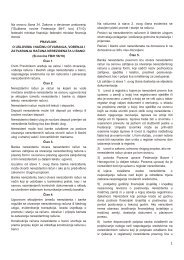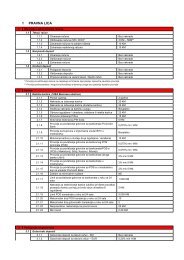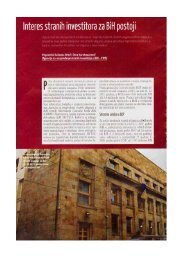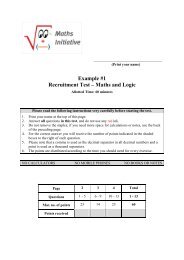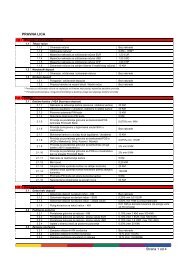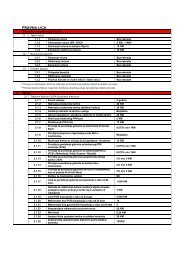Annual Report 2008 - ProCredit Bank
Annual Report 2008 - ProCredit Bank
Annual Report 2008 - ProCredit Bank
You also want an ePaper? Increase the reach of your titles
YUMPU automatically turns print PDFs into web optimized ePapers that Google loves.
48<br />
<strong>Annual</strong> <strong>Report</strong> <strong>2008</strong><br />
transaction costs. Subsequently, they are measured at amortised<br />
cost using the effective interest method.<br />
The <strong>Bank</strong> assesses at each balance sheet date whether there is objective<br />
evidence that loans and receivables are impaired.<br />
An allowance for loan impairment is established if there is objective<br />
evidence that the <strong>Bank</strong> will not be able to collect all amounts due<br />
according to the original contractual terms of loans. The amount of<br />
the provision is the difference between the carrying amount and<br />
the recoverable amount, being the present value of expected cash<br />
flows, including amounts recoverable from guarantees and collateral,<br />
discounted at the original effective interest rate of loans. The<br />
carrying amount of loans and receivables is reduced through the allowance<br />
account and the amount of loss is recognized in the income<br />
statement. Interest on impaired assets continues to be recognized<br />
through unwinding of the discount in interest income.<br />
If the amount of the impairment subsequently decreases due to<br />
an event occurring after the impairment was recognized, the previously<br />
recognized impairment loss is reserved by adjusting the<br />
allowance account. Subsequent recoveries of amounts previously<br />
written off are recognized as a reversal of impairment losses in the<br />
income statement. The provision for loan impairment is further analyzed<br />
in note 2.10.<br />
b) Financial assets available-for-sale<br />
Available-for-sale financial assets are non-derivative investments<br />
that are designated as available-for-sale or are not classified as another<br />
category of financial assets.<br />
Available-for-sale financial assets are initially recognised at fair<br />
value plus transaction cost that are directly attributable to its acquisition<br />
or issue. Regular-way purchases and sales of financial<br />
assets available for sale are recognised on trade date, which is the<br />
date when the <strong>Bank</strong> commits to purchase or sell the asset.<br />
Available-for-sale financial assets are subsequently measured at<br />
their fair value. Gains and losses from a change in the fair value of<br />
available-for-sale financial assets are recognized directly in a fair<br />
value reserve within equity. Equity instruments classified as available<br />
for sale that do not have a quoted market price in an active<br />
market and whose fair value cannot be reliably measured are stated<br />
at cost less impairment.<br />
Available-for-sale financial assets include equity securities. Dividends<br />
on available-for-sale equity instruments are recognised in<br />
the income statement when the entity’s right to receive payment<br />
is established.<br />
Financial assets are derecognised when the rights to receive cash<br />
flows from the financial assets have expired or where the <strong>Bank</strong> has<br />
transferred substantially all risks and rewards of ownership.<br />
2.7 Offsetting of financial instruments<br />
Financial assets and liabilities are offset and the net amount reported<br />
in the balance sheet when there is a legally enforceable<br />
right to set off the recognized amounts and when there is an intention<br />
to settle on a net basis, or realize the asset and settle the liability<br />
simultaneously.<br />
Income and expenses are presented on a net basis only when permitted<br />
by financial reporting standards, or for gains and losses<br />
arising from a group of similar transactions.<br />
2.8 Interest income and expense<br />
Interest income and expense are recognized in the income statement<br />
for all interest bearing instruments on an accrual basis using<br />
the effective interest rate, i.e. at the rate that discounts estimated<br />
future cash flows to net present value over the life of the underlying<br />
contract. Such income and expense is presented as interest<br />
and similar income or interest expense and similar charges in the<br />
income statement. Interest income and expense also includes fee<br />
and commission income and expense in respect of loans to and receivables<br />
from customers or borrowings from other banks, recognized<br />
on an effective interest basis.<br />
The effective interest method is a method of calculating the amortised<br />
cost of a financial asset or a financial liability and of allocating<br />
the interest income or interest expense over the relevant period.<br />
The effective interest rate is the rate that exactly discounts<br />
estimated future cash payments or receipts over the expected life<br />
of the financial instrument or, when appropriate, a shorter period<br />
to the net carrying amount of the financial asset or financial liability.<br />
When calculating the effective interest rate, the <strong>Bank</strong> estimates<br />
cash flows considering all contractual terms of the financial instrument<br />
(for example, prepayment options) but does not consider future<br />
credit losses. The calculation includes all fees and points paid<br />
or received between parties to the contract that are an integral part<br />
of the effective interest rate, transaction costs and all other premiums<br />
or discounts.<br />
2.9 Fee and commission income and expenses<br />
Fees and commission income and expenses mainly comprise fees<br />
received from enterprises arising from domestic and foreign payments,<br />
the issue of guarantees and letters of credit and credit card<br />
business. Fees and commissions, except for those which form part<br />
of the effective interest rate of the instrument, are generally recognized<br />
on an accrual basis when the service has been provided.<br />
2.10 Impairment losses on loans and advances<br />
The <strong>Bank</strong> assesses at each balance sheet date whether there is objective<br />
evidence that a financial asset or group of financial assets is<br />
impaired. A financial asset or a group of financial assets is impaired<br />
and impairment losses are incurred if there is objective evidence of<br />
impairment as a result of one or more events that occurred after the<br />
initial recognition of the asset (a “loss event”) and that loss event<br />
(or events) has an impact on the estimated future cash flows of the<br />
financial asset or group of financial assets that can be reliably estimated.<br />
Objective evidence that a financial asset or group of assets<br />
is impaired includes observable data that comes to the attention of<br />
the <strong>Bank</strong> about the following loss events:<br />
• significant financial difficulty of the borrower;<br />
• a breach of contract, such as a default or delinquency in interest<br />
or principal payments;<br />
• the <strong>Bank</strong> granting to the borrower, for economic or legal reasons<br />
relating to the borrower’s financial difficulty, a concession<br />
that it would not otherwise consider;<br />
• it becoming probable that the borrower will enter bankruptcy or<br />
other financial reorganisation;<br />
• the disappearance of an active market for the financial asset<br />
because of financial difficulties;<br />
• observable data indicating that there is a measurable decrease<br />
in the estimated future cash flows from a group of financial assets<br />
since the initial recognition of those assets, although the<br />
decrease cannot yet be identified with the individual financial<br />
assets in the group.<br />
If there is objective evidence that an impairment loss on loans<br />
and receivables carried at amortised cost has been incurred, the<br />
amount of the loss is measured as the difference between the asset’s<br />
carrying amount and the present value of estimated future<br />
cash flows discounted at the financial asset’s original effective interest<br />
rate. The carrying amount of the asset is reduced through the<br />
use of an allowance account and the amount of loss is recognized in<br />
the income statement. If a loan or receivable has a variable interest<br />
rate, the discount rate for measuring any impairment loss is the current<br />
effective interest rate determined under the contract.




